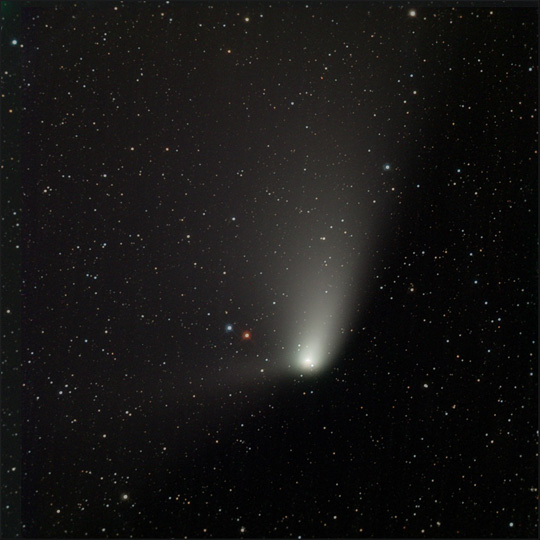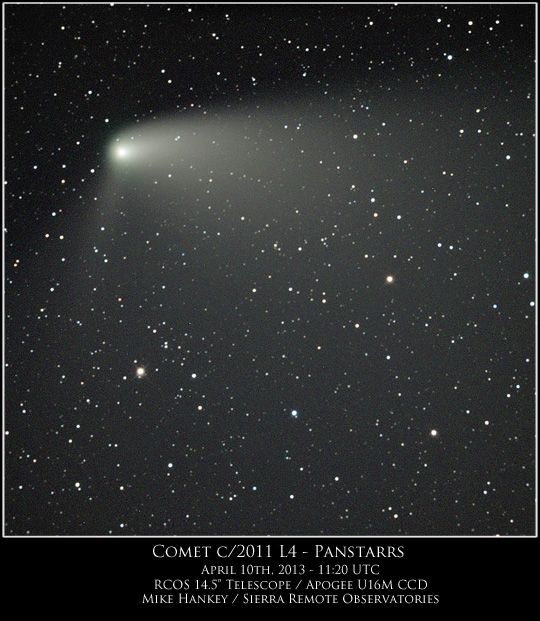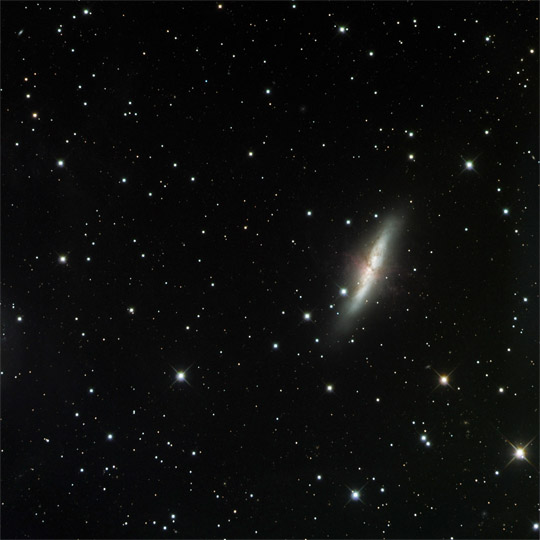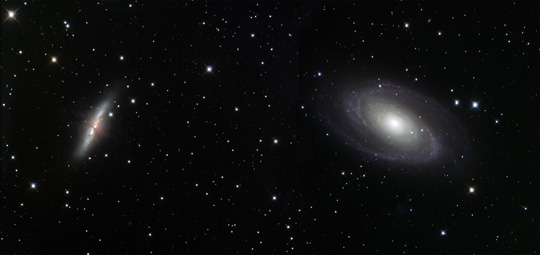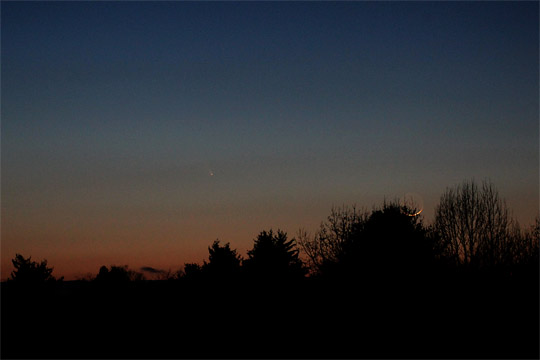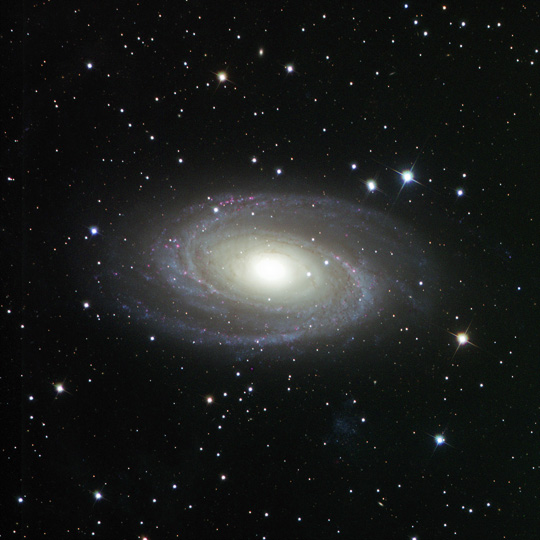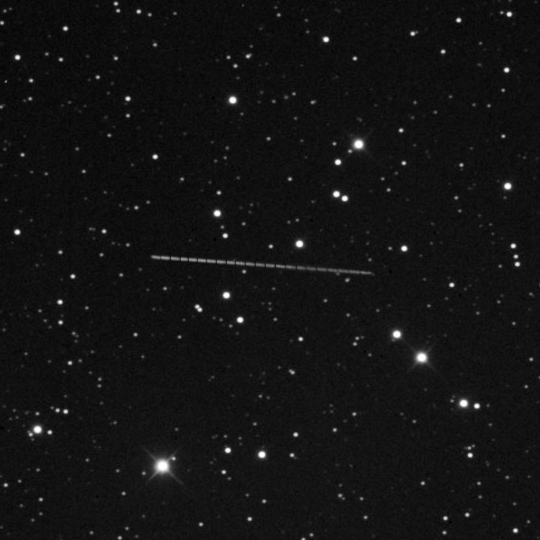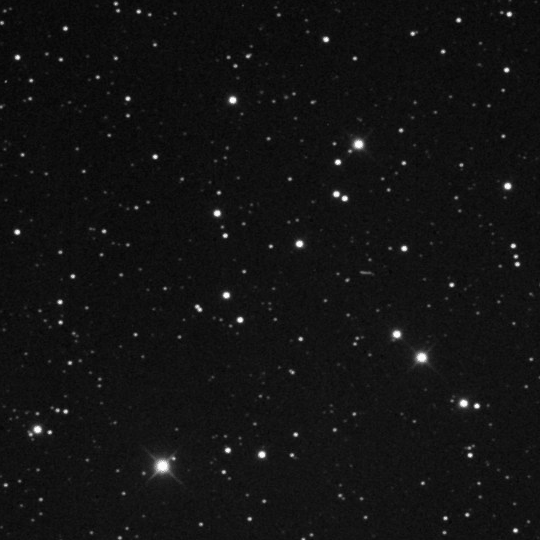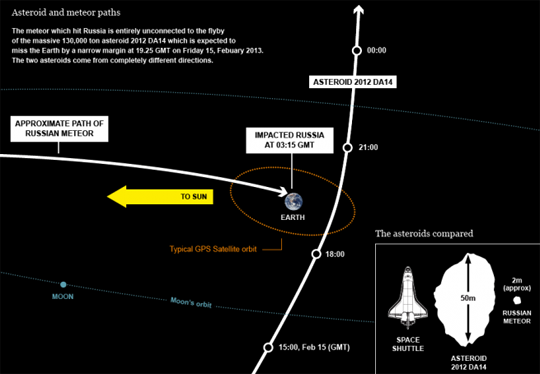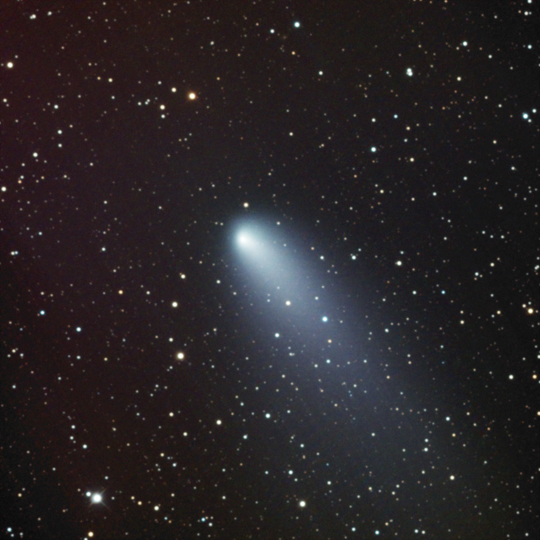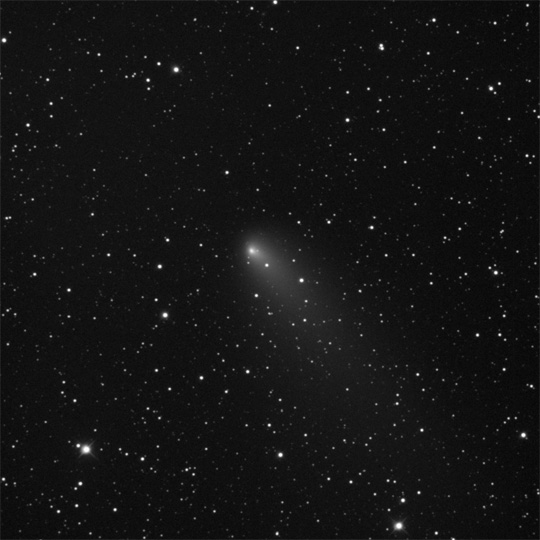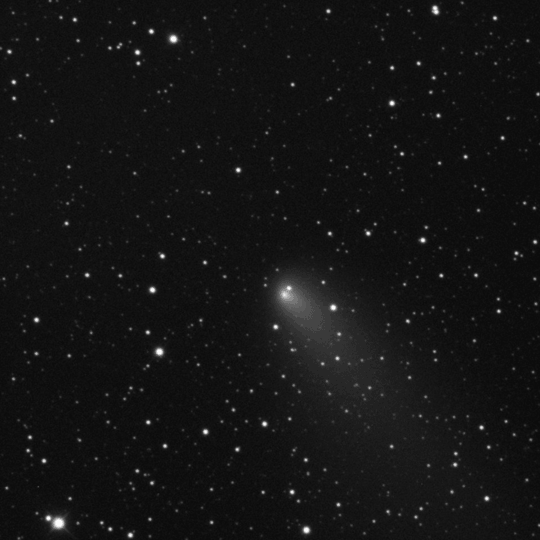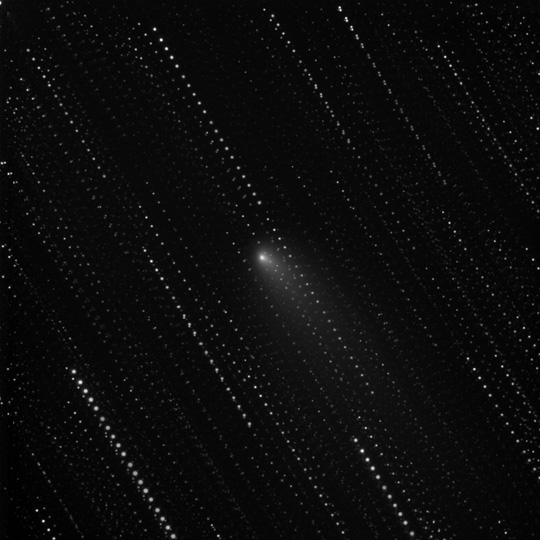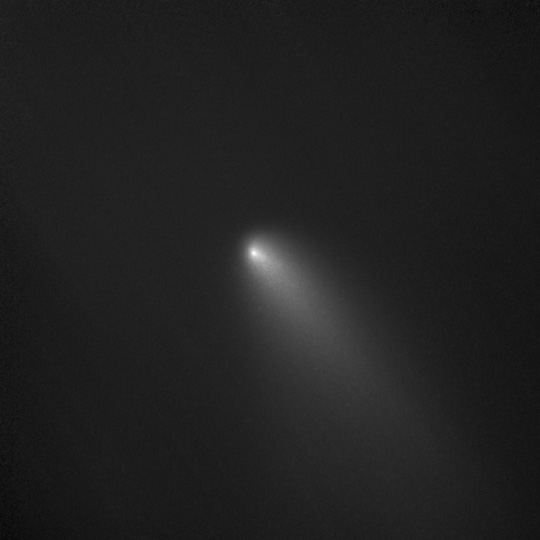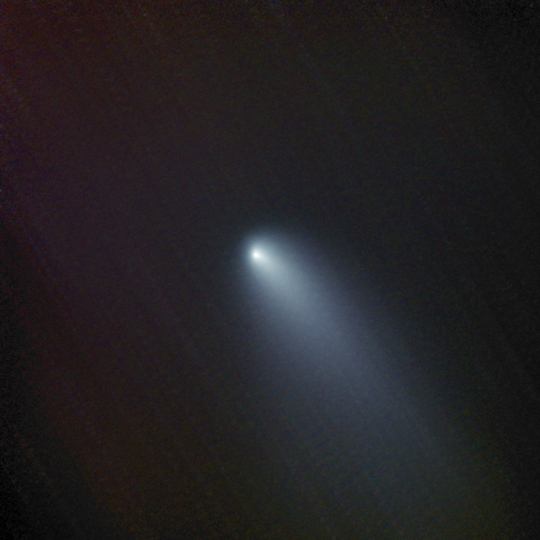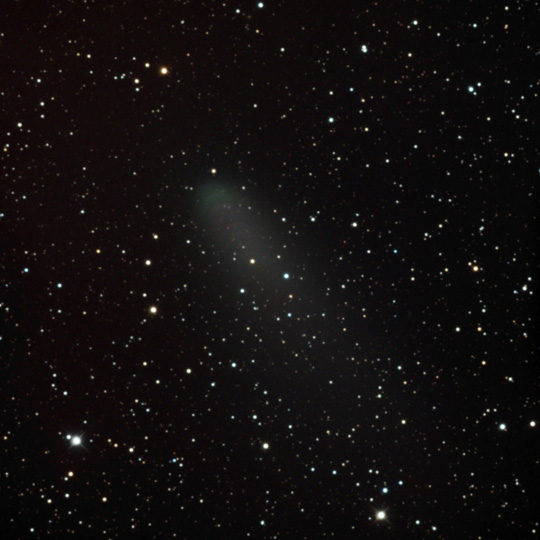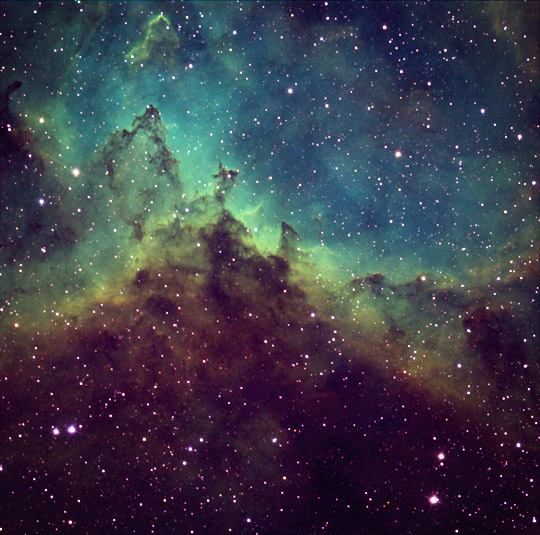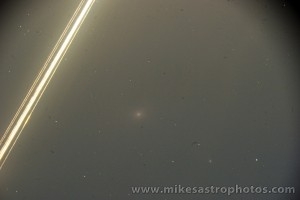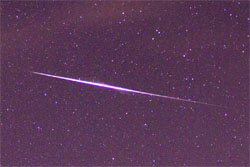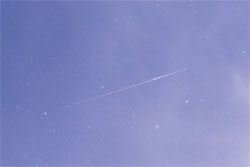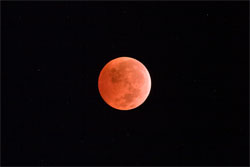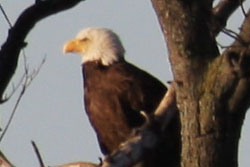Archive for 2013
More of Comet Panstarrs
by Mike Hankey, under Comets & Meteors
As time goes by and Comet Panstarrs flies deeper into the solar system, while it grows dimmer, its view-ability through a telescope is becoming increasingly better. Each day it rises higher in the morning sky and we have a few more minutes of visibility and time to image. I stepped up my exposure length this session, imaging each channel for 4 minutes. I was able to loop over these 5 times for LRGB and acquire 20 minutes of each channel. Turned out pretty good.
Photo Details
C/2011 L4 – Panstarrs
LRGB 4 minutes x 5 or 20 minutes each channel
Total exposure: 80 minutes
Camera: Apogee U16M
Guider: unguided image
Telescope: RCOS 14.5
Mount: Paramount ME
Location: Auberry, CA
Date: Apr 18, 2013
Software: The SkyX, MaximDL, FocusMax, CCDStack, Photoshop
Comet C/2011 L4 – Panstarrs
by Mike Hankey, under Comets & Meteors
The last week or two, there’s been a 45 minute window each morning to catch comet Panstarrs in the north east sky. I missed the western evening view in March, as it was to close too the horizon, but this morning north eastern view is working out pretty well. Here’s a 30 second X RGBL image of Comet Panstarrs.
Photo Details
C/2011 L4 – Panstarrs
LRGB 3o seconds Each
Total exposure: 2 minutes
Camera: Apogee U16M
Guider: unguided image
Telescope: RCOS 14.5
Mount: Paramount ME
Location: Auberry, CA
Date: Apr 10, 2013
Software: The SkyX, MaximDL, FocusMax, CCDStack, Photoshop
A Galaxy in Peril M82
by Mike Hankey, under Galaxies
I haven’t had much time for astrophotography lately, especially with all of the fireballs falling, but I did finally get around to processing and finalizing this picture of Messier 82, A Galaxy in Peril. I slowly acquired data for this image over the month of February and for various quality reasons had to disgard about 2/3s of it. The processed image below is the result of 9 total hours worth of exposure time gathered over a two week period.
While it looks like this galaxy is exploding or being torn apart, astronomers believe the red filaments extendending outward from its core are ionized gases being blown out of the galaxy by solar winds and super nova explosions.
M82 is close enough to M81, that I was able to join the images into a nice mosaic of both galaxies.
Photo Details
M82
LRGB 1400x1200x1200x1200 Minutes Each
Total exposure: 9 hours
Camera: Apogee U16M
Guider: SBIG 402 with MMOAG Off Axis Guider
Telescope: RCOS 14.5
Mount: Paramount ME
Location: Auberry, CA
Date: Feb 2013
Software: The SkyX, MaximDL, FocusMax, CCDAutoPilot, CCDStack, Photoshop
Comet Panstarrs and Crescent Moon
by Mike Hankey, under Comets & Meteors
Here’s a photo of Comet Panstarrs and the Crescent Moon from earlier tonight in Monkton, Maryland.
Bode’s Galaxy – M81
by Mike Hankey, under Galaxies
I had to take a break from astrophotos for a little while at the beginning of the year to focus on some Earth based projects. In addition to not having the time, I had lost some of my inspiration and motivation for the work. When I finally got back into it, I realized there were a bunch of things I had been doing wrong. I had been rushing through the process to get to the end result, but not spending the time on the details and fine points needed to consistently create quality photos. As a result, fundmental problems with my procedures were preventing me from seeing clearly. After some time away, these errors were apparent and I spent a good bit of effort on each aspect trying to perfect it or at least get it working better. After a few weeks of slow paced, calm progress I started to get the results I was looking for (or at least better results!)
Here’s my first galaxy photo of the new year, Messier 81, aka Bode’s Galaxy. For reference purposes, here’s a Hubble photo of the same object.
Here’s a an extra big high-res 3200×3200 version of this galaxy picture.
Photo Details
M81
LRGB 1200x600x600x600 Minutes Each
Total exposure: 5 hours
Camera: Apogee U16M
Guider: SBIG 402 with MMOAG Off Axis Guider
Telescope: RCOS 14.5
Mount: Paramount ME
Location: Auberry, CA
Date: Feb 5,6,7 2013
Software: The SkyX, MaximDL, FocusMax, CCDAutoPilot, CCDStack, Photoshop
Asteroid 2012DA14 and Russian Meteor
by Mike Hankey, under Comets & Meteors
Yesterday, February 15th, 2013 was an exciting day in the meteor world. Of course it started off with the the Russian Fireball that caused quite a stir (see American Meteor Society article on Russian Meteor)
Coincidentally, yesterday was also the day Near Earth Asteroid 2012DA14 passed by at 27,743 kilometers (17,239 mi) above Earth’s surface. I had wanted to image the asteroid last week, but due to it approaching from below the Earth, it was only visible from the southern hemisphere. By chance, I was up late last night doing some work on the scope and I had previously tagged the asteroid in the SkyX (telescope control program). I noticed it was out and realized that after its closest approach it was now moving away from northern hemisphere and thus I could see it nicely from California!
I shot the asteroid for about 2 hours. Here is a composite image of 20 2 minute frames. There is a short pause in between each frame. The asteroid appears to get brighter as it moves, but i think this is really just the effect of clouds / seeing in between the shots.
Here is an animation of the same series of pictures.
*The streak that appears towards the end of the animation above, I believe is a part of a satellite flare.
Also to note, the Asteroid 2012DA14 and the Russian meteor are NOT related. Below is a diagram of the orbits created by SETI which clearly shows how these two events could not be related to the same stream of meteoroids. See this graphic from SETI & Wired magazine, click graphic to read article.
Comet C/2012 K5 LINEAR – Redux
by Mike Hankey, under Comets & Meteors
I bought my first telescope before the new year of 2009 and took my first astrophoto on Jan 7th, of that year, literally 4 years ago today. The inspiration that compelled me to buy that telescope, look up at the sky and document what I saw is still going strong four years later and it kept me up until dawn last night imaging comet K5 Linear! This comet was discovered in May of 2012, went around the Sun in November and just past Earth a few days ago on December 31th missing us by a mere 28 million miles. Yesterday, January 6th was the feast of the Epiphany, a Christian Holiday celebrating the revelation that God was born as a human being in Jesus Christ. Many scholars hypothizize that the star that led the magi to Bethlehem to celebrate this revelation could have been a comet. For me astronomy, has been a great Epiphany and the joy that comes from learning about the Universe is all powerful and never ending. Peace to you in 2013!
Here is a brief tutorial on how to image comets.
Imaging comets is a little tricky because they are moving pretty quickly and you have to take short exposures or else the comet will streak through the picture. You can track the comet, but then the stars in the picture will streak. There are additional challenges when trying to get a color photo because by the time you cycle through the red, green, blue and luminance filters the comet has moved significantly enough to cause alignment issues within itself (not to mention the stars). Over time, I have learned a few tricks about imaging comets that I will explain here.
First, here’s the trick — to get your final nice comet image you need to be able to stack on just the comet in one picture while washing out all of the stars and then with another picture, you stack on the stars and wash out the comet. Once this is done you combine the two images into the final product. If you’re doing this for color, then its the same process you just have to do it 4 different times (once for each color channel RGB plus the clear Luminance filter). Now here’s the trick, in order to wash out the stars and the comet, there needs to be sufficient space in between the stars and objects in all frames — the stars can not overlap. In order to run the error suppression routines, the stars must have spaces in between them.
Here’s an example of a single 60 second exposure using the Luminance filter. We will need 20 of these before the final luminance channel can be completed.
Knowing that we need to space out the exposures to allow the comet to move enough so that the stars don’t overlap in-between frames, the most efficient way to acquire the data is setting up a loop that switches filters in-between each exposure, for example: Red, Green, Blue, Lum, Dark, Pause, Loop x 20). I throw the dark in there because we will need to calibrate the pictures and this is a nice way to use some time and space it out a little more. The pause time may not be needed or it can be whatever is necessary to space out the comet in between frames. If you setup the acquisition routine like this with a 10 second pause there will be at least 5 minutes before each filter repeats.
Here’s an animation of 7 60 second luminance frames, each spaced out over 10 minutes, so this is 70 minutes of comet flight time. (If the image below is not moving, please give it a minute to load.)
Now once we have collected our data if we were to align the frames centering on the comet itself and then stack without error reduction the image would look like this (note the spaces in-between the stars).
Using poison sigma error correction we can then wash out all of the stars during the stacking process. Poison sigma will essentially delete anything that is not the same between two frames, so if the stars are not touching they will be deleted.
Once we have done this for all of our frames (Red, Green, Blue, Lum) we combine them to make the color image of the comet.
We can then re-align the frames on the stars and use the poison sigma error reduction to wash out the comet.
Now that we have our two color master frames, we can line them up together as layers in photoshop. Put the comet on top and then change the layer type to Luminosity and wa-la! The final comet image is ready! It took 80 pictures exposed for 60 seconds each to create this final image.
Photo Details
Comet 2012/K5 (Linear)
20×60 Seconds of LRGB Binned X 3
Total exposure: 1 hour 20 minutes
Camera: Apogee U16M
Guider: SBIG 402 with MMOAG Off Axis Guider
Telescope: RCOS 14.5
Mount: Paramount ME
Location: Auberry, CA
Date: 1/7/2013
Software: The SkyX, MaximDL, FocusMax, CCDStack, Photoshop
Heart Nebula – IC 1805
by Mike Hankey, under Nebula
Here’s part of the Heart Nebula, an emission nebula found in the constellation Cassiopeia. This expansive mixture of glowing interstellar gas and dust is over 200 light years wide and covers 2.5 degrees in the night sky — that’s a cloud of dust that would appear 5 times the size of the moon! Too bad we can’t see it with our naked eye, but turn a telescope with narrow band filters on it for a few hours and this is what you get. Click the pictures below for a high res version 1800×1750 pixels big.
In order to capture the entire nebula with my current telescope I’d need make a mosaic using 6-8 pictures like the one above.
Photo Details
The Heart Nebula – IC 1805
Ha, Oiii, Sii @ 120x120x120 Minutes Each – Hubble Palette
Total exposure: 6 hours
Camera: Apogee U16M
Guider: SBIG 402 with MMOAG Off Axis Guider
Telescope: RCOS 14.5
Mount: Paramount ME
Location: Auberry, CA
Date: 1/1/2012, 1/2/2013
Software: The SkyX, MaximDL, FocusMax, CCDAutoPilot, CCDStack, Photoshop
